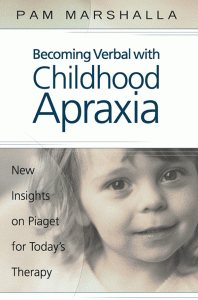I’ve been meaning to do a post on imitation for awhile. May 14th is the first Apraxia Awareness day so I thought a post on imitation skills would be appropriate.
Imitation abilities one of the things that I assess during an initial evaluation. Speech therapy uses a lot modeling techniques so having a child who can imitate is an positive prognostic sign for how therapy will proceed. For children who exhibit difficulty with imitation, this will be my initial focus in therapy.
In order to imitate, a child needs to attend to people in their environment. They also need to have an understanding of cause and effect. (My actions cause others to do something.) If I can get a child to spontaneously imitate other people, then they can start learning and expanding their language in a variety of places.
Just say “Ah.”
For a child who is nonverbal, I start by teaching “Ah” or another consistent vocalization on command. I will observe the child to see what sounds they are able to produce and start with a vocalization that is already in their repertoire.
One time I had a client who could only produce raspberries. We would read a repetitive book like Brown bear, brown bear and they would read along. “Pfft PFft, Pfft, pfft, pfft pffft pfft pffft.” This student was REALLY trying to say the words.
Children who don’t have volitional control often have very loud, or noises that we might consider distracting or inappropriate. Sometimes they end up with a behavioral program to extinguish this behavior. This is heartbreaking to me. We are telling are kids who are just trying to make whatever sounds they can to be quiet, to STOP talking.
Instead, we should be helping them explore their vocal range. Can they learn to louder/quieter? Can they find the middle? What different sounds can they make? Completing a functional behavioral analysis would help to find alternative communicative behaviors which could be addressed through augmentative communication.
Once we have established a consistent vocal response then we begin to add in more consonant-vowel (CV) and vowel consonant (VC) productions. I will spend some time with vowels in isolation because vowels carry much of the meaning of a word. I don’t spend very much time if any on consonants in isolation.
Nonverbal Imitation:
I want to make sure that the child I am working with is able to do imitate a variety of big and small motor movements. If I start to the run-will they run with me? Can they imitate a clap or touch their head? Are they able to imitate my play actions during a pretend play activity.
Having pairs of the same toy are really helpful for teaching nonverbal imitation. For example, you could each have a drum and practice drumming slow together and then fast.
If all else Fails:
Sometimes a client I see just doesn’t understand imitation at all. For those clients, I will spend a lot of time imitating what they are doing. (it can take up to a year!) This works better for some patients than others. A lot of times though I will start to see an increase in attention towards me or the parent as the client starts to realize that we are imitating them. Pamella Marshalla has a fantastic book on teaching imitation called: Becoming Verbal with Childhood Apraxia.
If you have a client who is not imitating, this book explains how to further breakdown imitation to improve the child’s ability to control their speaking.
Do you teach imitation? If so I’d love to hear your favorite materials and tricks!



[…] 9. Teaching Imitation […]